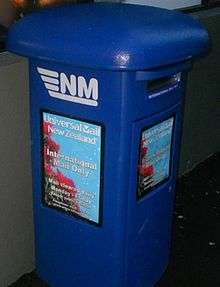Mail sack



A mail sack or mailsack is a mail bag used to carry large quantities of mail.
Different handling and security requirements for different classes of mail is integral to the postal rate structure, and is tied to regulation and rates for the mail under the auspices of the postal rate commission.
A mail sack is not a locked bag since they need little security. In contrast to a similar mailbag — referred to as a mail pouch (for more sensitive mail such as personal letters and military mail) that employs a locking mechanism on the top of the bag. A mail pouch has special closely spaced eyelets and a strong strap to secure the top where access into the bag is closed off and locked, where a mail sack has none of these features.[1]
During World War I it was typical of German soldiers to write postcards to their family to keep in touch to let them know where they were and what they were doing. The various ultimate destinations of the postcards were sorted into German "mail sacks" of that time period (1914-1918) by behind the scenes post-office troops.[2]
In the United Kingdom, the term "mail sack" is more expansive and generic, and typically involves larger bags that contain mail destined for one destination.[3]
A Singapore judge held that mail sacks are considered to be part of the postal system and are protected by Chinese law; interference with them can be the subject of criminal prosecution.[4]
Etymology
- According to Online Etymology Dictionary the etymology of "satchel" is mid 14th century from Old French sachel from Latin of saccellum (money bag, purse) and sacculus or saccus (bag or sack).[5]
- This etymology dictionary also describes "sack" as a large cloth bag. It says that sakkus is probably from Greek, from an early borrowing from Latin of saccus. It is also from Old French of sac, Spanish of saco, and Italian of sacco. It apparently is also from the Greek sakkos, from Semitic (cf. Hebrew saq "sack").[6]
United States Postal System
Second-class mail
Second-class mail that would be carried in a mail sack is periodical publications issued at stated intervals and is issued a minimum of four times a year. This type of mail must have a date of issue and a consecutive numbering system. It also must have a real office where the publication comes from that is open during normal regular hours of business. The printed matter can not be stenciled, mimeographed or through a hectograph process. Second-class mail must be publications for distributing information of a public character (e.g., literature, sciences, industry information). The people that receive this second-class mail must be subscribers that are on some sort of list or in a customer database.[7]
Third-class mail
Third-class mail that would be carried in a mail sack is printed material weighing less than 16 ounces. Examples are circulars that are not of a personal nature (e.g. mass general public advertising, direct advertising mailing campaigns). Other third-class mail that would be carried in a mail sack is bulk mail that is presorted individually addressed letters that come in quantities of at least 50 pounds or mailings of over 200 pieces.[7]
Fourth-class mail
Fourth-class mail that would be carried in a mail sack is printed material weighing over 16 ounces. An example would be library books transferred through the Interlibrary loan system.[7]
M-bags, also called "Direct Sacks"
A special type of mail sack is one that is used to transport bulk mail, particularly printed matter, to a single recipient at a single foreign address. There is no minimum weight, and the maximum is a tare weight of 66 lbs.[8] An M-bag is 4 feet tall and 36 inches in diameter.[9] Every piece of mail in an "M-bag must be marked 'Postage Paid - M-bag.'"[9] This type of shipping is especially prized by book stores and peace corps volunteers. It is an economical and secure way to move a lot of mail over a great distance on the surface (not air mail). Plans to discontinue this service originating in the USA in 2007 met with opposition.[10] In August, 2007, subsidized rates were drastically curtailed. This gave rise to "complaints from everyone from scholars to record-album collectors - all of whom bemoan the loss of subsidized rates for research and educational (which includes entertainment) materials."[10] See Private Mail Bag.
Foreign mail sack
A mailbag used to transfer mail to a country other than the United States is defined as a "foreign mail sack". The normal design is that the top is closed with a drawstring like a leather strap. It is sealed using a lead seal (not a lock as in a mail pouch).[11]
Australian post pickup service


Australia has pre-paid mail sack service within the country. A person buys a pre-paid "satchel" (mail sack) to put mail into. The "satchels" (mail sacks) can be bought in bulk (sets of 10) for further discount. The sizes are 500 gram, 3 kg, and 5 kg. The "satchel" (mail sack) full of mail is then placed into an Australian red post box at certain street locations for pick-up. The "satchels" (mail sacks) can also be taken to the nearest post office for processing, especially if it is too big to fit through the opening of the street red post box. Certain paperwork must be filled out, especially if it is going by airmail. A proof of mailing is available with an additional fee paid at the post office (Australian retail outlet). There is an online tracking tool available for this pre-paid mail sack service.[12]
New Zealand international mail
New Zealand International Air Satchel is a discount service for the transport of large amounts of international mail from New Zealand. The mail is put into blue mail "satchel" bags (a type of mail sack provided by the New Zealand post office) and has free pick-up service available. The delivery of this international mail service from New Zealand is projected to be 3 to 10 working days. The discount service applies if a shipment of international mail is 100 New Zealand dollars or more. The requirements for this discount international mail service is that it must be over 50 international airmail letters or a set of small packages with a total mail fee cost of over 100 New Zealand dollars. The packages must be under 2 kg each. International airmail letters must weigh under 200 grams each, otherwise they are charged as a parcel package. If certain paperwork is filled out and pre-arrangements are made then a free courier pick-up service is available (1 per day).[13]
See also
Bibliography
Footnotes
- ↑ Melius p. 40
- ↑ "Bayer. Feldpostexpedition Alpenkorps". Flickr. Retrieved 23 September 2012.
- ↑ "Mail sack". All Business Dictionary. Barron's Educational Series, Inc. Retrieved 23 September 2012. Compare, "mail bag". Oxford English Dictionary. Retrieved August 16, 2012.
- ↑ Alkhatib, Shaffiq (21 June 2010). "Man pleads guilty to stuffing rubbish, faeces into SingPost letterbox". Singapore: Singapore News. Retrieved 23 September 2012.
- ↑ "Satchel". Online Etymology Dictionary. Retrieved October 6, 2012.
- ↑ sack (n.1) "Sack" Check
|url=value (help). Online Etymology Dictionary. Retrieved October 6, 2012. - 1 2 3 Division of the Federal Register, United States. Federal Register Division, United States. Office of the Federal Register, U.S. Government Printing Office, 1984, pp. 313-332. (Google eBook)
- ↑ "260 Direct Sacks of Printed Matter to One Addressee (M-Bags)". Postal Explorer. United States Postal Service. 2006. Retrieved September 2, 2012.
- 1 2 "M-Bag (Direct Sacks of Printed Matter to One Addressee". United States Postal Service. Retrieved September 5, 2012.
- 1 2 "Death of USPS Surface Mail ( & the M-Bag )?". Nicaragua Living. Retrieved October 13, 2012.
- ↑ "Foreign mail sack". Arago Researcher Program Style Guide for Researchers and Editors. Smithsonian Institution. Retrieved September 23, 2012.
- ↑ "Prepaid parcel post plus satchels". Australia Post. Retrieved 23 September 2012.
- ↑ "International Air Satchel". New Zealand Post. Retrieved 23 September 2012.
Sources
- Melius, Louis (1917). The American postal service: history of the postal service from the earliest times. The American system described with full details of operation. Washington, D.C.: National Capital Press. Retrieved August 15, 2012. at Internet Archive
Further reading
- Cushing, Marshall (1893). The Story of Our Post Office: The Greatest Government Department in all its Phases. Boston, Massachusetts: A.M. Thayer & Co. at Internet archive
External links
| Wikimedia Commons has media related to mail bags. |